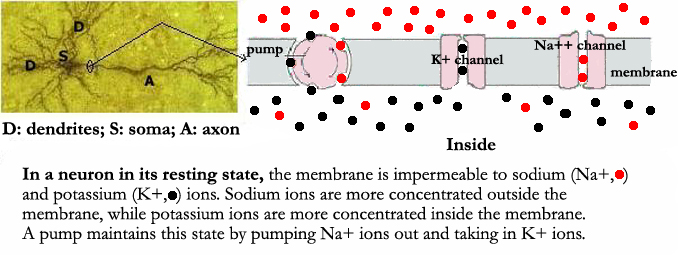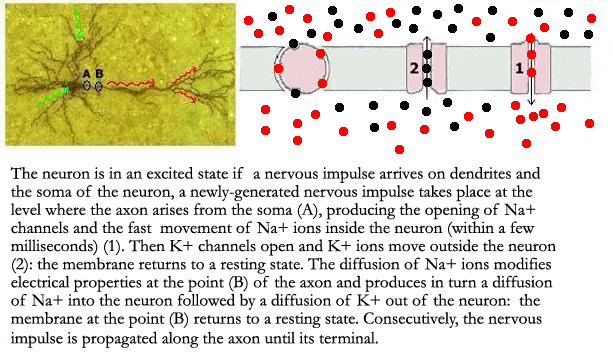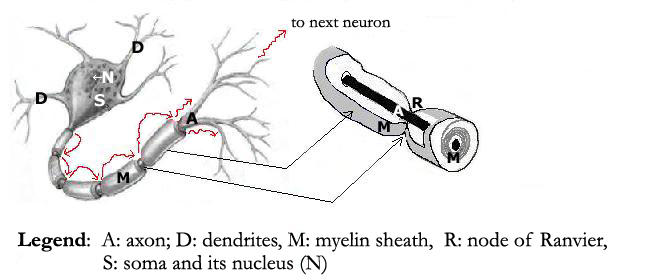The neuron is different from the other cells in its capacity to generate an electric signal that is called a nervous impulse. These signals – known as action potentials – are transmitted from one neuron to another and ensure the functional activity of the brain.
How are these signals transmitted?
Neurons are separated from their environments by a fine layer (a few thousandths of a millimetre thick) called the cell membrane. Channels – valves allowing passage of ions – in the cell membrane enable these signals to be transmitted.
No signal: the neuron is at rest
If there is no signal, the neuron is at rest and sodium (Na+) and potassium (K+) channels are closed. The membrane of the neuron is normally polarized: this is called the resting potential. During the resting state, the outside of the neuron is positive compared to the inside because there is more positive charge (in particular Na+ ions) outside the neuron than inside (K+ is more highly concentrated within the cell).
A signal arrives: the neuron is excited
When a nervous impulse arrives, ionic channels are activated and positive Na+ ions drive into the cell in a fraction of a second (K+ ions drive out the neuron a short time later): the inner part of the membrane becomes positively charged. A nervous impulse is generated and is propagated from the cell body to the axon terminal at a speed of 1 to 150 meters a second. Its amplitude is approximately 100 millivolts (0.1 volt is equal to 100 millivolts) and its duration is from approximately 1 to 2 thousandths of a second.
Where does the neuron receive the nervous impulse from?
The reception takes place on the membrane of dendrites and the cell body (the cell body is also called soma) of the neuron. A neuron can receive information from approximately one thousand neurons. The axon can also receive impulses.
Where is the nerve impulse generated?
The neuron integrates the input messages and generates an action potential which takes place in the area (called initial segment) where the axon leaves the soma.
How is the nerve impulse propagated?
The opening of Na+ channels in a given area (A) stimulates the membrane of the adjacent area which becomes in its turn excitable, opening Na+ channels there… and so on. So the nerve impulse is propagated. It should be noted that the membrane located in area A of the axon returns to the resting state: Na+ channels close while potassium channels open, letting potassium ions drive out of the neuron. The nervous impulse is transmitted to another neuron or another type of cell (for example a muscular cell) via the synapse (the contact between one neuron and the next).


Certain axons possess a sheath (an expansion of the membrane of glial cells) that is rolled up in a spiral around the axon and called the myelin sheath. This sheath ensures propagation of the nervous impulse up to 200 times faster (100 meters a second) than in an axon without myelin. The myelin is separated (every 1 to 3 millimetres) by spaces called nodes of Ranvier (Ranvier: French histologist of the 20th century). These spaces (a length of some thousandth of millimetre) are very excitable because they contain the majority of the ionic channels. The nervous impulse jumps from one node to the next thereby increasing the speed of transmission: this is called saltatory conduction.

The structure and the composition of the neuronal membrane and the myelin sheath change during normal brain aging, resulting in a reduction of the speed of the nervous impulse conduction. This reduction could be at the origin of the cognitive decline.
